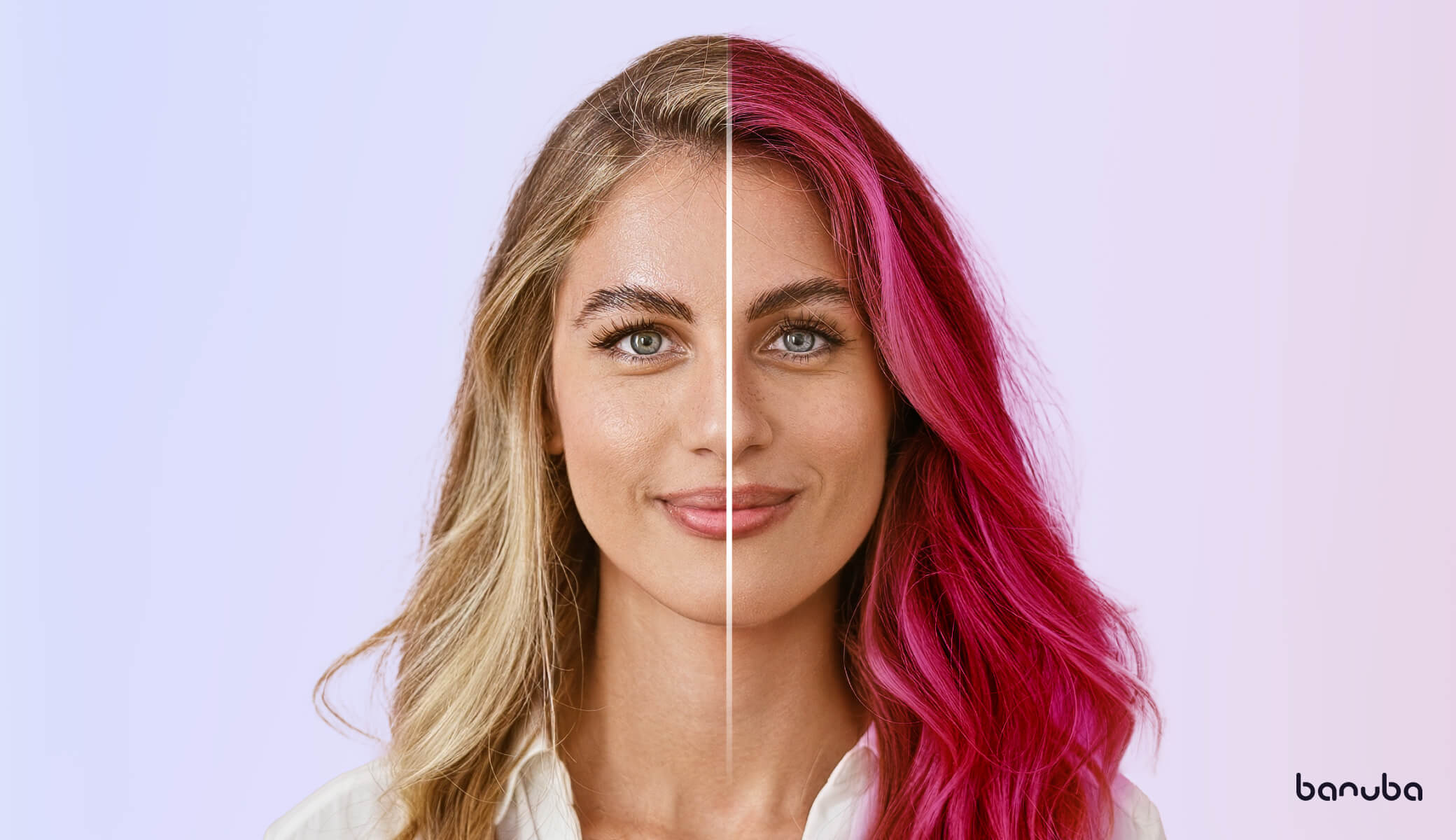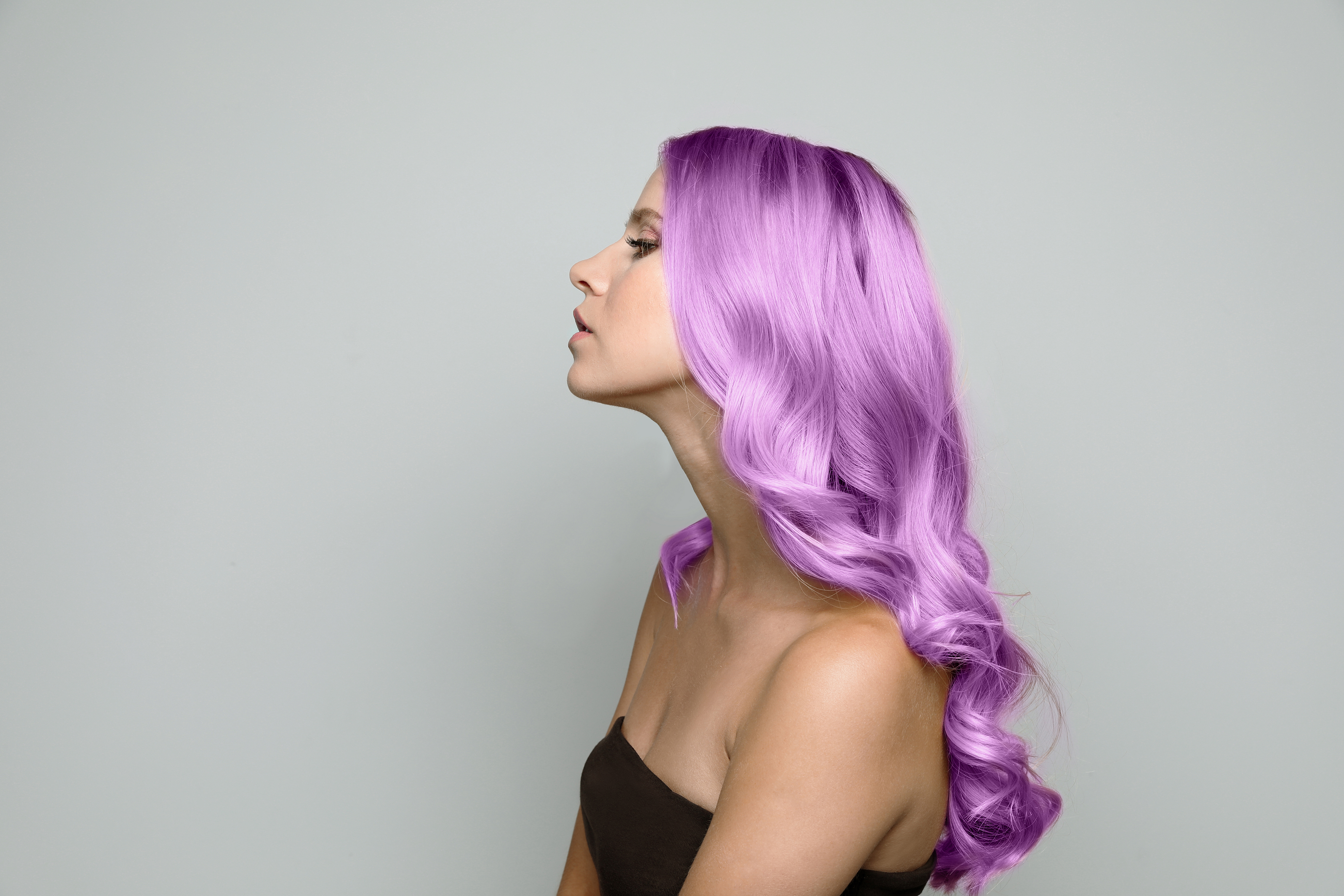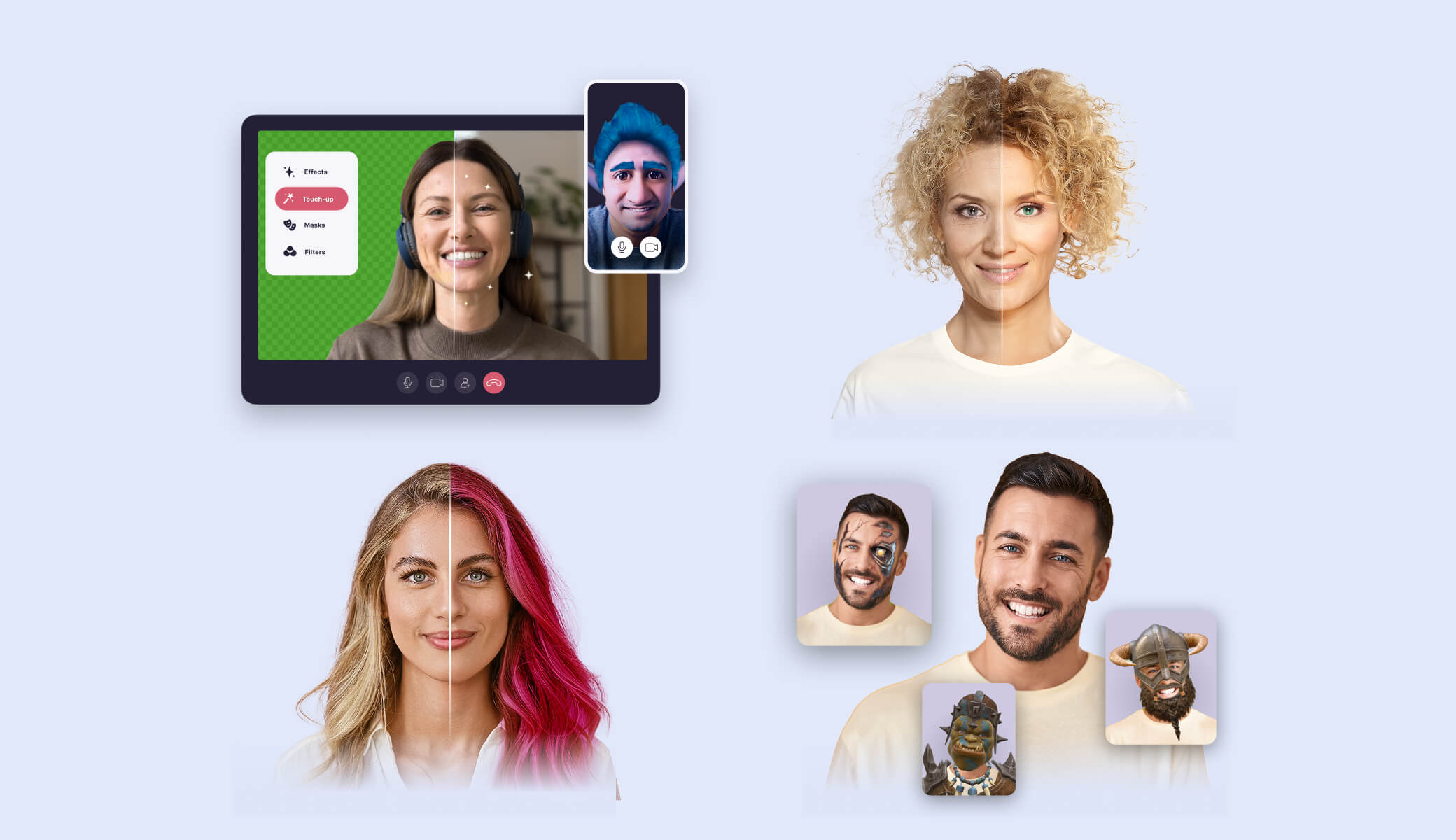Best Hair Segmentation SDKs for Apps in 2025
AR is a must in many digital experiences. Over 61% of consumers prefer brands that offer AR-powered features, such as real-time hair coloring in beauty, virtual try-on in retail, and AR masks and filters in entertainment.
For apps leveraging augmented reality, it means 200% higher engagement. But delivering that level of realism, especially when it comes to hair, is incredibly complex.
Hair is one of the hardest elements to segment in computer vision. It’s multi-textured, semi-transparent, varies wildly in shape and color, and reacts differently to light and motion. Training a reliable model in-house takes months of R&D, massive annotated datasets, and constant optimization for mobile performance.
The AR market is growing at an astonishing CAGR of 37.9% per year, and it has evolved dramatically, offering off-the-shelf advanced solutions, mainly software development kits (SDKs). Ready-made hair segmentation SDKs enable you to integrate hair detection, coloring, and styling features seamlessly, with real-time performance, AR support, and cross-platform compatibility.
In this guide, we compare the best hair segmentation SDKs for 2025, focusing on Banuba, ModiFace, and DeepAR, to help you select the best-matching solution for your needs.

[navigation]
TL;DR:
- Hair segmentation is identifying and processing hair in the image;
- The fastest way to implement it in an app is to use an SDK - a packaged solution that you can merge with your product in a few lines of code;
- Hair segmentation SDKs decrease the time-to-market, allow for similar codebase across multiple platform, and improve UX;
- Top hair segmentation SDKs include Banuba, ModiFace, and DeepAR;
- To choose the optimal one, consider platform compatibility, feature set, and other factors;
- Common integration challenges include supporting different recoloring types, optimization for multiple devices, and ensuring good performance under various conditions.
What is Hair Segmentation Technology?
Hair segmentation is a specialized subfield of image segmentation in computer vision. It involves identifying and isolating pixel-accurate hair regions from real-time camera input, static images, or videos.
Unlike basic background removal, which treats large objects, hair segmentation requires the model to understand soft boundaries, transparency, and fine details, such as flyaways and layered textures.
In short, the model analyzes patterns in the image, classifies each pixel as either hair or not, and then continuously adjusts the output to stay in sync with live camera input, even when the user moves, turns, or changes the lighting.
In 2025, hair segmentation has evolved from obviously overlayed filters and effects for social media platforms to photo-realistic, personalized, and interactive experiences across industries and platforms. AR has become more immersive and mainstream, with pixel-perfect hair rendering at its core.
SDK vs. Building From Scratch
Most internal teams underestimate the effort and cost of developing a reliable in-house hair segmentation solution. It will take months to gather the qualified team, to architect, develop, test, and finally produce the first version of just one feature for your application.
The bare minimum you’ll need includes:
- A large, diverse dataset with dense annotations specific to hair contours and textures;
- Domain-specific training on deep learning architectures;
- Post-processing routines for refining masks and eliminating artifacts;
- Real-time inference optimization for mobile GPUs;
- Continuous testing across lighting conditions, skin tones, hairstyles, and devices.
Real-World Use Cases in 2025
Hair segmentation technology powers a range of features across industries:
- Virtual try-on experiences for hair color and styles in AR beauty apps and retail (Garnier, L’Oreal, Loncolor). L’Oreal, which includes nearly 40 global brands within its ecosystem, sees a 150% increase in virtual try-on usage by its consumers;
- Live video filters and effects in social platforms and live chats. Bermuda received over 15 million monthly AR interactions in its live chat app.
- Hair detection and recommendations in AI-driven personalization tools for choosing the best matching hairstyle, color, makeup, etc.;
- Avatar customization and animation in gaming and metaverse apps. For example, the adopted avatar personalization helped the Clash of Streamers achieve 100k active monthly users and over 4+ million installs;
- Remote consultation solutions in the salon and haircare market, or an in-house preview of expected results.
Key Takeaways
- Hair segmentation enables realistic AR effects by precisely isolating hair in images and video;
- Building it from scratch is costly and time-consuming, often requiring 6–9 months and a full cross-functional team;
- SDKs offer a faster, more cost-effective alternative with ready-to-use models and cross-platform support;
- In 2025, hair segmentation is powering AR beauty apps, social filters, gaming avatars, and salon tools across industries.
Benefits of Using Hair Segmentation SDKs
A hair segmentation SDK or API provides development teams with a significant head start.

Here’s what the right SDK brings to the table in 2025:
Faster Time to Market
Pre-trained models, integration toolkits, and ready-to-use components mean you can go from prototype to production in weeks, not quarters. That’s critical in competitive markets like AR beauty and mobile apps.
Enhanced UX
Hair segmentation SDKs deliver real-time, accurate hair effects that feel seamless and responsive, enhancing the overall user experience. They help increase engagement, extend session duration, and attract new target audiences.
Customization for All Hair Types
Machine learning models are trained on diverse datasets, which allows SDKs to accurately segment curly, straight, short, long, light, and dark hair, ensuring inclusivity and realism for a global audience.
Cross-Compatibility
Top solutions are built to run seamlessly across iOS, Android, and the web, often with support for Unity or React Native. This makes it easier to deliver consistent UX regardless of device or OS.
Simple Integration
Most SDKs come with clear documentation, sample code, and demo versions that make hair segmentation integration fast and developer-friendly. In most cases, teams also receive comprehensive assistance and guidance throughout the entire process, ensuring a smooth implementation across both mobile and web platforms.
Key Takeaways
- Hair segmentation SDKs help teams ship faster with pre-trained models and out-of-the-box components;
- They deliver real-time, accurate hair effects that improve UX and boost user engagement;
- Trained on diverse datasets, they support all hair types with inclusive and realistic results;
- Cross-platform compatibility ensures a consistent experience on iOS, Android, and Web;
- Integration is fast and well-supported, with clear docs, sample code, and hands-on assistance.
Top Hair Segmentation SDKs in 2025
Now, let’s compare three market leaders in hair segmentation SDKs in 2025.
Banuba Hair Segmentation SDK
Banuba’s Hair Segmentation SDK stands out in 2025 for its AI-powered precision, designed specifically for real-time AR experiences, fast performance, and smooth integration across platforms.
What sets it apart is its ability to handle the real-world complexity of hair, including frizz, movement, lighting variations, and diverse textures, all in real-time. Additionally, it can be combined with other try-on features, such as beauty products, accessories, and a background changer, to create an ultimate virtual try-on experience.
“The collaboration between Banuba and Scorpion Technology was smooth and efficient. The teams worked closely together to achieve the established objectives and meet Loncolor's expectations. The process was well-organized and results-oriented” - Gigi Nuta, CEO, Scorpion Technology
“Our hair segmentation engine was built to handle the hardest cases in real time — overlapping strands, frizz, occlusion, and poor lighting. We optimized it down to mobile GPU level so developers don’t need to compromise between visual quality and performance.” - Artem Harytonau, Chief Technology Officer at Banuba
It offers a wide range of hair colors and styles, dynamic hair animation, and can be fully customized to match your brand. It's also lightweight, AR-ready, and comes with straightforward documentation, sample codes on GitHub, and hands-on support.
In its recent update, Banuba’s Hair Segmentation SDK improved its advanced hair detection system and added the ability to dye separate hair strands in different colors.
Try it firsthand via their live demo or explore the full potential of Banuba’s AR hair color toolkit.
Core Features:
- AI-powered hair segmentation and real-time virtual coloring;
- Dynamic hair animation and extensive color/style range;
- Lightweight performance optimized even for low-end devices;
- Easy integration for iOS, Android, Web, Unity, and Mac;
- Patented face tracking tech with 3,308 facial landmarks;
- White-label and fully brand-customizable;
- 22,000+ digitized beauty products available for pairing;
- Dedicated developer support and fast integration process (1–2 weeks).
Pros:
- Highly accurate and responsive in real-time environments;
- Explicitly designed for AR beauty, e-commerce, and mobile apps;
- Excellent cross-platform support with rapid onboarding;
- Deep customization and visual quality control.
Cons:
- Requires camera permissions and live input to unlock full potential.
Pricing: Custom with 14 days of free trial.
ModiFace Hair Segmentation SDK
ModiFace, acquired by L’Oréal, is one of the earliest players in the AR beauty tech space. Its hair segmentation SDK is part of a broader suite with a clear emphasis on enterprise beauty brands.

While not as developer-centric as Banuba or DeepAR, ModiFace’s offering focuses on web and mobile e-commerce platforms in the cosmetics industry.
ModiFace supports mobile SDKs for Android and iOS, as well as WebAR integrations via browser-based components. However, SDK access is typically limited to brand partners or enterprise clients.
Core Features:
- Real-time hair segmentation and color simulation;
- Integrated with ModiFace’s full AR beauty suite;
- Predefined and brand-customized hair color palettes;
- Compatible with iOS, Android, and Web;
- Hair Care Diagnostic tool available as an add-on;
- Machine learning-based hair mask generation.
Pros:
- Proven at scale with global beauty brands;
- Strong color simulation quality;
- Good brand-facing UI and marketing tools.
Cons:
- Limited access for smaller developers or startups;
- Less flexible for non-beauty or entertainment use cases;
- Heavily geared toward L’Oréal’s product ecosystem.
Pricing: Custom.
DeepAR Hair Segmentation SDK
DeepAR offers a comprehensive AR engine for face tracking, virtual try-ons, and beauty effects, supporting iOS, Android, Web, and Unity platforms. However, when it comes to hair segmentation, functionality is currently limited to iOS only. The feature is available as part of DeepAR’s Ultimate Beauty package and includes a range of ready-to-use hair color effects, but teams building for Android or cross-platform environments will find this a limitation.
Core Features:
- Real-time hair segmentation and virtual coloring (iOS only)
- Studio-packaged hair color effects, including single hair color, two-color gradients, half-dye block, multicolor, and full RGB range;
- Includes prepared template files for easy import; Integrated with DeepAR’s face/body tracking and AR filter suite;
- iOS only — hair segmentation features are currently not available on Android or Web.
Pros:
- Easy-to-use Studio templates for common hair color effects;
- Real-time segmentation performance tailored for iOS devices;
- Seamlessly integrated with face tracking and other AR features;
- Freemium tier allows experimentation before scaling.
Cons:
- Limited to only one OS;
- Depth of segmentation and realism are less advanced than specialized beauty-first SDKs;
- Requires requesting feature access; not available out-of-the-box for all plans.
Pricing: Offers a freemium developer tier, with segmentation unlocked on request. The Professional and Enterprise plans scale by MAUs and feature support.
Key Takeaways
- Banuba offers the most complete and customizable solution — with AI-powered segmentation, dynamic hair animation, cross-platform support, and advanced AR integration. Ideal for beauty, fashion, and e-commerce apps;
- ModiFace is a proven enterprise tool trusted by major beauty brands, but it’s limited in flexibility and typically available only to L’Oréal partners;
- DeepAR supports robust AR features but limits hair segmentation to iOS only, making it best suited for lightweight try-on use cases on Apple devices;
- Pricing models vary: Banuba and ModiFace offer custom quotes, while DeepAR has a freemium model with gated features.
How to Choose the Right Hair Segmentation SDK in 2025
Here are the core points to consider when choosing the best-matching hair segmentation SDK for your application:
Consider Project Requirements
Start by defining what your app needs:
- Accuracy: Does the SDK produce clean, realistic segmentation across various hair types, styles, and lighting conditions?
- Real-Time performance: Can it run smoothly on your target devices without latency or frame drops?
- Platform compatibility: Ensure the SDK supports your chosen environment (iOS, Android, Web, or cross-platform frameworks such as Unity or Flutter);
- Customization options: Do you need full control over visuals, branding, or hair effects? Some SDKs are more flexible than others.
Evaluate Ease of Integration and Developer Support
Time-to-market is critical. Look for SDKs that provide:
- Step-by-step documentation;
- Sample code and live demos;
- Responsive developer support or onboarding assistance
This ensures your team can integrate the SDK with minimal friction and get help quickly if needed.
Assess Pricing Models and Budget Constraints
Some providers offer free tiers for testing and small-scale apps, while others follow a commercial licensing model. If your team is budget-conscious or prototyping, start with SDKs that offer transparent pricing or trial access. For enterprise-level apps, factor in long-term support and scalability.
Check for Unique Features
Look beyond the basics:
- AR support for face tracking and interactive effects;
- Hair animation to simulate realistic movement;
- Color libraries with gradients, block styles, and RGB ranges;
- White-labeling options for brand alignment.
These extras can significantly improve user experience and make your app stand out.
Review Real-World Use Cases and Client Success Stories
Explore how other companies use the SDK. Are there public apps, case studies, or demos available? Proven success stories demonstrate a mature and reliable product, offering valuable insights for effective implementation.
Key Takeaways
- Define your project’s needs including segmentation accuracy, real-time performance, platform compatibility, and customization flexibility;
- Prioritize SDKs with clear documentation, code samples, and responsive developer support to ensure smooth and fast integration;
- Evaluate pricing options based on your budget and app scale look for free trials or transparent licensing if you're prototyping;
- Seek unique features like AR support, hair animation, color libraries, and white-labeling to deliver standout user experiences;
- Review case studies and real-world deployments to ensure the SDK is field-tested and trusted by industry leaders.
Common Challenges and Best Practices
Here are six common challenges developers, businesses, and product owners face when opting for hair segmentation SDKs for their solutions and ways to fix them:
Handling Diverse Hair Types, Colors, and Backgrounds
Challenge: Hair comes in endless variations and behaves differently under various lighting and angles, especially in motion. Complex backgrounds can also confuse the segmentation model.
Solution: Choose an SDK trained on a diverse dataset that supports multi-ethnic, multi-textured hair. Test across varied user profiles and include extreme cases during QA. Tools like Banuba excel in this area thanks to AI adaptation and lighting-aware segmentation.
Ensuring Real-Time Performance and Low Latency
Challenge: Even 100 – 200 ms of lag in hair rendering breaks the illusion of realism in AR, especially for mobile apps and live try-on experiences.
Solution: Go for SDKs with GPU-accelerated inference and low memory consumption. Test on mid-range devices, not just flagships, and check at high frame rates (30-60 frames per second). Prefer SDKs optimized for mobile AR from day one.
Optimizing for Mobile Devices and Different Lighting Conditions
Challenge: Many segmentation models work fine in studio-like conditions but struggle in real-world lighting, especially on older or mid-tier devices with lower camera quality.
Solution: Use SDKs that offer dynamic lighting adaptation and are optimized for resource-constrained hardware. Real-time performance shouldn’t come at the cost of image quality. Look for solutions that adjust masks and overlays in response to the surrounding light.
Customizing for Branding and Unique App Experiences
Challenge: Out-of-the-box AR effects rarely match a brand’s design system or user interface needs. Visual mismatch can hurt UX and weaken brand perception. Especially when your UI within the feature looks identical to that of your competitor who uses the same SDK.
Solution: Choose SDKs that allow white-labeling, custom overlays, and full control over UI integration. Ensure color palettes, animation styles, and transitions can be adapted to match your brand tone and voice.
Leveraging AR Features for Higher User Engagement
Challenge: Hair segmentation alone won’t retain users. It must be part of a more engaging AR experience. Without added interactivity, users may try the feature once and drop off.
Solution: Layer hair segmentation with other AR features like face filters, gesture tracking, product previews, and AI recommendations. Gamify the experience or offer dynamic style suggestions to increase time-in-app and conversion potential.
Key Takeaways
- Ensure the SDK supports diverse hair types and lighting conditions by selecting one trained on inclusive datasets and optimized for real-world use;
- Real-time AR demands low-latency performance, so prioritize SDKs with GPU acceleration and mobile optimization;
- For consistent quality, choose solutions with dynamic lighting adaptation and performance tuning for mid-range devices;
- Go beyond default settings: white-labeling and UI customization are essential for delivering a brand-aligned experience;
- Hair segmentation works best when combined with engaging AR features like filters, recommendations, and try-on tools to drive retention and boost user interaction.
Conclusion
AR in digital isn’t just a trend; it’s the new black. If you want to grasp new audiences, retain users, and increase revenue, the shift to AR-powered features like real-time hair try-ons and virtual coloring is no longer optional; it’s inevitable.
In today’s hyper-competitive market, the fastest and smartest way to stand out isn’t by building everything from scratch. It’s by partnering with a reliable, tech-savvy provider offering ready-to-use hair segmentation SDKs. Banuba, ModiFace, and DeepAR are the top contenders. But if you want to stay future-proof, avoid platform limitations, and deliver cutting-edge performance across industries, Banuba is the ultimate choice.
Explore Banuba’s hair segmentation demo and discover how its suite of SDKs can transform your app with real-time AR hair color, virtual try-ons, and personalized beauty experiences that keep users coming back.
Reference List
AR-go. (2025, February 5). 6 powerful impacts of e-commerce that no one tells you in 2025. https://www.ar-go.co/blog/6-powerful-impacts-of-e-commerce-that-no-one-tells-you-in-2025
Banuba. (n.d.). AR hair color changer. https://www.banuba.com/hair-color-changer
Banuba. (n.d.). How Bermuda uses Face AR SDK for beauty, wellness, and ecommerce. Banuba. Retrieved July 10, 2025, from https://www.banuba.com/blog/bermuda-face-ar-sdk-case
Banuba. (n.d.). FAQ: What is hair segmentation? https://www.banuba.com/faq/what-is-hair-segmentation
Banuba. (n.d.). Virtual try-on for a Romanian hair color brand. https://www.banuba.com/blog/virtual-try-on-for-a-romanian-hair-color-brand
Banuba. (n.d.). Face AR SDK documentation: Hair coloring. https://docs.banuba.com/face-ar-sdk-v1/effect_api/face_beauty#hair-coloring
Banuba. (n.d.). Case studies. https://www.banuba.com/blog/tag/case-study
BytePlus. (n.d.). How to build a hair segmentation model. https://www.byteplus.com/en/topic/16866?title=how-to-build-a-hair-segmentation-model
DeepAR. (n.d.). Beauty and makeup. https://www.deepar.ai/beauty-and-makeup
DeepAR. (n.d.). Ultimate beauty guide (iOS only). https://docs.deepar.ai/deepar-studio/guides-and-tutorials/ultimate-beauty/#hair-color-ios-only
Garnier USA. (n.d.). Virtual try-on. https://www.garnierusa.com/beauty-services-and-tools/virtual-try-on
Grand View Research. (n.d.). Augmented reality market size, share & trends analysis report. https://www.grandviewresearch.com/industry-analysis/augmented-reality-market
Labelbox. (n.d.). Image segmentation guide. https://labelbox.com/guides/image-segmentation/
L'Oréal Paris USA. (n.d.). Virtual hair try-on. https://www.lorealparisusa.com/virtual-try-on-hair
ModiFace. (n.d.). Hair products. https://modiface.com/products-hair.html
PYMNTS. (2024, February 2). L’Oréal sees 150% increase in virtual try-ons as consumers seek AR immersion. https://www.pymnts.com/news/retail/2024/loreal-sees-150percent-increase-in-virtual-try-ons-as-consumers-seek-ar-immersion/
Reydar. (n.d.). Augmented reality in retail: Stats, benefits & examples. https://www.reydar.com/augmented-reality-retail-stats-benefits-examples/
Threekit. (2023). 23 augmented reality statistics you should know in 2023. https://www.threekit.com/23-augmented-reality-statistics-you-should-know-in-2023
Think with Google. (n.d.). AR shopping interest statistics. https://www.thinkwithgoogle.com/consumer-insights/consumer-trends/ar-shopping-interest-statistics/
TikTok. (n.d.). Hair color filters. https://www.tiktok.com/discover/hair-color-filters
Ulta Beauty. (n.d.). Virtual hair try-on experience. https://www.ulta.com/innovation/experiences/hair/
Indeed. (n.d.). Machine learning engineer salaries. https://www.indeed.com/career/machine-learning-engineer/salaries
Gordon, D. (2023, July 31). The best hair segmentation SDKs for in-app integration. Medium. https://medium.com/@davegord86/the-best-hair-segmentation-sdks-for-in-app-integration-afe045674b09






